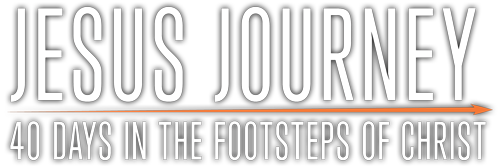Day 8
Messiah Headquarters
The Philippines. Sri Lanka. India. Brazil. Iraq. Eritrea. Italy.
Switzerland. Martinique. Mexico. Ethiopia.
All responses to my question, “So, where are you from?” And all heard just this morning.
Our group is walking the pilgrim path into Capernaum. We’re far from alone. Just like in the days of Jesus’ earthly ministry, he still has crowds of followers eager to meet him. And they are from all over.
It’s expanding my vision of the Body of Christ. I’m getting a worldwide, God’s-eye view.
But it’s a view Jesus had from the start.
You can tell by looking at a map.
ON THE WAY OF THE SEA
After he’s kicked out of Nazareth, Jesus very strategically chooses the town of Capernaum to be his headquarters for much of his ministry.
Why? Capernaum was not big or important or well known. But as you’ll see, his choice was deliberate — and brilliant.
Capernaum is on the northern shore of the Sea of Galilee. That’s the largest freshwater lake in Israel. It resembles the shape of a harp when seen from the surrounding hills, which is where it gets its Hebrew name, “Sea of Kinnereth” or, in Greek, “Sea of Gennesaret.” These words are related to the Hebrew kinnor, meaning “harp.”
In ancient times, an international trade highway called the Via Maris skirted a few miles of Galilee’s shoreline. One of the most important roads in the entire ancient world, Via Maris literally means “The Way of the Sea.” Remember that phrase.
The Via Maris connected three continents. It came down from Europe and Asia in the north via Damascus to the top of the lake. Then it ran down the northwest shore for a few miles until it shot further westward toward the coast, and from there it led south to Egypt and Africa.
Capernaum, in a narrow valley between the lake and the mountains, was the official toll station on the Via Maris as travelers entered or left Galilee.
That meant virtually any traveller between Rome, Greece, Syria, and Persia in the north, and Judea, Egypt, Ethiopia, or the rest of Africa in the south, had to travel right past this village. Little Capernaum would have seen much more international traffic than even Jerusalem, which was far larger and more famous, but in an inland valley away from the trade routes.
BORDER TOWN
What’s more, Capernaum was almost right on the border between the two regions ruled by warring sons of Herod the Great: Herod Antipas governed the more Jewish western side of Galilee, and his hated brother Philip ruled the eastern side.
So when things got hot in one lakeside territory, Jesus could just hop on a boat and sail over to the other side of the lake, which was controlled by a different government. This kept him safe until the time was right for him to lay down his own life.
FAR FROM THE MEDDLING CROWD
Since Capernaum is on the extreme northern side of the lake, it’s about as far from Jerusalem and the meddling religious authorities down in the southern province of Judea as you can get — and still be in Jewish territory.
And Capernaum is a very nice place. The ancient Jewish writer Josephus praised its climate. He wrote,
Its nature is wonderful as well as its beauty… Its soil is so fruitful that all kinds of trees can grow upon it… it supplies people with the principal fruits, with grapes and figs continually during ten months of the year; besides the good temperature of the air, it is also watered from a most fertile fountain. The people of that country call it Capharnaum…. 14
In other words, if Jesus wanted to influence the whole world from his home country with as little interference from religious authorities as possible, and live in a nice place to boot, Capernaum was the best choice.
It worked. Matthew talks about the instant, international extent of Jesus’ popularity:
News about him spread as far as Syria… Large crowds followed him wherever he went — people from Galilee, the Decapolis, Jerusalem, from all over Judea, and from east of the Jordan River. Matthew 4:24–25
This was not only intended by Jesus; it was specifically prophesied. Matthew describes how Jesus…
…went and lived in Capernaum, which was by the lake in the area of Zebulun and Naphtali — to fulfill what was said through the prophet Isaiah: “Land of Zebulun and land of Naphtali, the Way of the Sea (Notice this phrase? The Way of the Sea was the Via Maris), beyond the Jordan, Galilee of the Gentiles — the people living in darkness have seen a great light; on those living in the land of the shadow of death a light has dawned.” Matthew 4:13–16
PARTY AT PETER’S HOUSE
In the ruins of Capernaum, archaeologists have discovered several buildings that actually date to the time of Christ!
The most impressive ruin in Capernaum today is the limestone synagogue from around the fourth century AD, dated by thousands of coins found beneath the pavement. But it’s easy to see how the white limestone was laid on top of another building made of black basalt rock. Dated by pottery found on the floor, this older synagogue is from the time of Christ — probably the very building in which he taught!
And the story behind another ruin is even more astounding. Experts discovered, under an ancient church, the ruins of a house from the time of Christ. It was about a block from the synagogue, right on the lakeshore — apparently a fisherman’s house.
Ancient Christian graffiti in Aramaic, Greek, Syriac, and Latin naming both “Lord Jesus Christ” and “Simon Peter” has been found on the walls. Excavators believe that, shortly after the ministry of Christ, this was venerated as the house of Simon Peter!
The house was apparently used as a church as early as the mid-first-century AD, remodeled over the years to accommodate bigger crowds. It remains the most ancient Christian place of worship yet found. Its location fits the evidence in the Bible; the house of Peter was a short walk from the synagogue in Capernaum (see Matthew 8:5, Mark 1:29).
Since its discovery, a unique glass-bottom church was built over the site. You can now sit in modern pews and look down beneath your feet at a two-thousand-year-old house Jesus probably ministered in.
On this afternoon, I watch as many of those very pilgrims I met earlier in the day enter the church. Some pray. Some sing. Others weep. I find the atmosphere charged with joy and excitement.
From across the world, speaking languages unknown to one another, we have all been drawn here, bound by something stronger than the name of the country on our passport: We were sought out and found by the one we worship today. We were lost sheep of other folds, who heard the call of the one shepherd.
Even in his choice of Capernaum as a headquarters, Jesus is continuing to reveal the DNA of the gospel. It’s always been about cross-cultural, international outreach. From the start, Jesus was showing that God is a God for all humanity. He is concerned about redeeming all people, everywhere.
From the very beginning, the Messiah came not just for Israel, but for the entire planet — and that includes you!
Now that he’s got an amazingly strategic headquarters, what kind of talented, A-list, high-capacity people will Jesus recruit when he puts together his staff? You will be surprised.
Ponder
What implications are there for your own attitudes and priorities when you see how intentionally Jesus reached out to the whole world?

 Buy Jesus Journey at Amazon.com
Buy Jesus Journey at Amazon.com